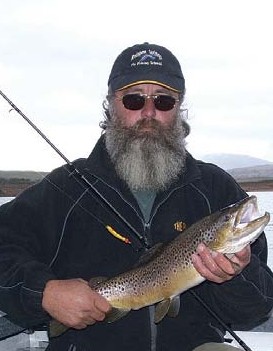 Presented from Issue 115, April 2015
Presented from Issue 115, April 2015
As April and May progress the days are shorter and they for one thing sure are colder. But the trout angler in many of us still ‘needs’ to head up top chasing those that challenge us.
End of season trout should, as a general rule, be hungry. Either pre or post-spawn. They generally feed well pre-spawn. Feeding before they move up the many streams, creeks, rivers and canals that provide the breeding grounds. The process sees the trout with little or no food for some time hence the need to add condition for energy during this very strenuous spawning period.
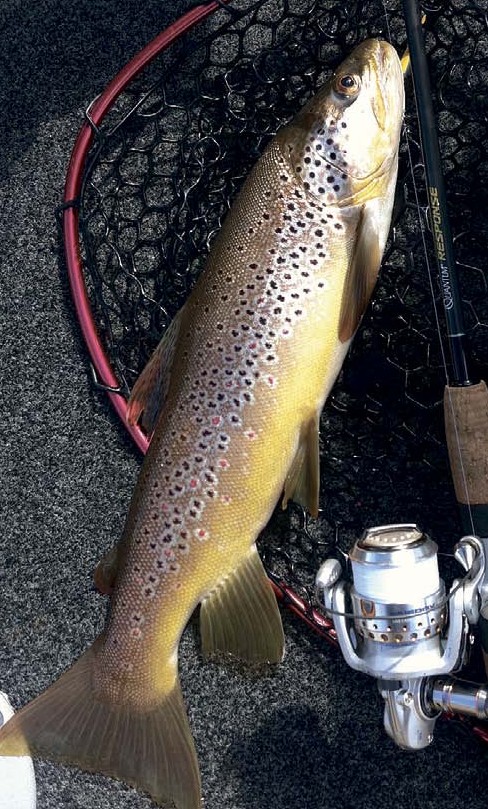 |
| A nice one from Great Lake |
Blessed we are in Tassie to be never much more than an hour or so from many of our highland lakes from our major population centres, we have many choices if the lakes and impoundments are on the radar. So what’s different about this time of the year compared to the remainder of the season? The trout can be localised if they are readying to spawn. If they have spawned, assuming you are fishing a year round water, they will also be a little more localised although they do tend to spread pretty quickly.
The bite itself can be somewhat reactionary. Using bright colours such as fluro orange, red or pink will often increase your hit rate at this time of the year. While hot pink is a proven trout catcher in Tassie Devil styled lures world-wide I tend to lean towards the flouro orange or red colours. It’s very rare now I’ll throw a lure without orange on it year round these days.
Days gone by
I remember vividly as a high school student fishing Lake Sorell around the Easter break. Trolling around the waters on the eastern Hatchery Shore as it was known. You could look out from the small open dinghy and see literally hundreds of trout free leaping from the water. Now these were, and given the tremendous fishery Sorell was, not small trout. They averaged close to 1.5kg up there out of the water and probably around 1.2kg cleaned. When these fish were ‘on the fly’ so to speak they weren’t all that easy to catch.
It may have been by chance that the bright lure scenario was discovered in our younger years as we always had the green and gold theory drummed in to us by the old timers ‘that knew best’ and when an adult tells a kid what he should use, you know what’s going to happen. Hot pink certainly wasn’t a colour used in Tassie for a long, long time and has only just become popular locally in the last two or three seasons. We tended to opt then for either red and gold or a bright red Tassie Devil. Another favourite was a Nils Master with a frosty green back, yellow flanks and a bright red throat. Who knows why, I guess we didn’t understand the reasons back then, we just knew they caught fish and Easter break was the time to start using them.
In the 25 years since those days I guess you could say we have revised and improved our tactics targeting these trout.
Choosing the right lure
I’ll cover this first as for me it’s something that doesn’t really change regardless of location anywhere in the state. At the end of the season the first thing I tie on is black, gold and orange. It doesn’t matter what brand or style that’s my weapon of choice. That said I don’t think it matters what’s on the lure with the orange, I believe that is the key. So much so I’ve used all orange Tassie Devils to great effect right through the season. Stick fluoro orange under an ultraviolet light and perhaps that’s a clue to the reason why. Not only is it bright to our eyes, the UV glow out of a fluoro orange is astounding. It’s long been accepted that UV signatures can be a big factor in stimulating fish to attacks a lure. Keeping it local look no further than Cranka Lures with their minnows; Salmon Guts, BBQ Prawn, Fire Trout and Golden Trout will all get the job done. Another gun colour for end of season, and right through the year, is the Spotted Dog variations. YEP Tassie Tackle has a gem in the Golden Seducer. While I’ll fish this out of the box through the year I love to tinker with lures and this gets a pimping job with a blast of you guessed it fluoro orange right along its belly for late season trout.
The Hawk Snipers also fitting the bill with a black and gold and also from their new custom range the Ghost Prawn (orange) should fool more than a few silly trout up top.
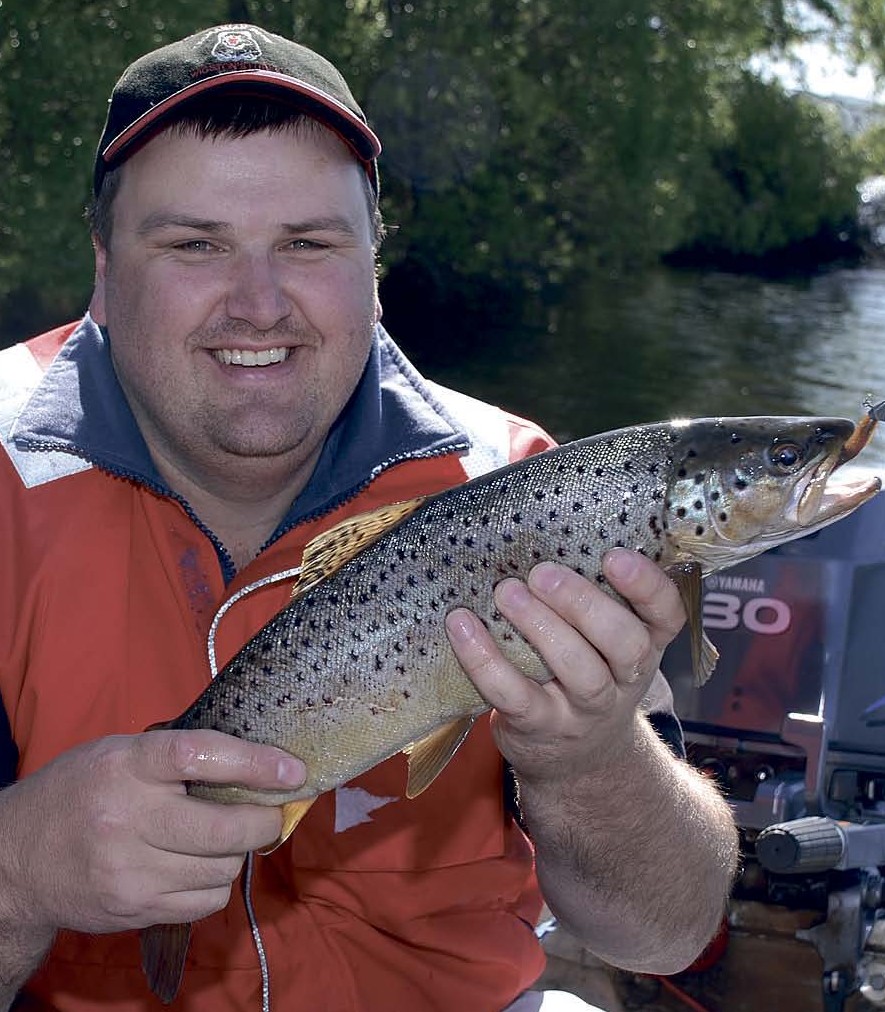 |
| Another catch from Meadowbank |
For those trolling or throwing heavier lures the Tassie Devil Range has some standouts colour wise; #102 Bengal Tiger, #110 Perch, #56 Fireball and #126 Smashing Pumpkin all great choices. The #PP Phosphorus Pearl also excellent particularly fished deep on lead line.
Taking some cues from our neighbours in New Zealand who have, although it’s not publicised unlike it’s incredible fly fishery, one of the best trolling fisheries in the world. The fish that they catch puts to shame most others world-wide. Some very different tactics are employed but lure choice is at times very similar with one significant change. They love white or in particular white pearl as a base colour.
When fishing soft plastics again I’m headed straight for the Pumpkinseed colours. Local manufacturer Strike Tiger has a great colour in the Vodka n Orange and in darker water the Toffee Apple has a good contrast being somewhat denser in colour. I also find that the translucent greens also stand out extremely well with their UV signatures but that’s a colour I’ll fish earlier in the year. Strike Tiger, Z-man and the old school Wasabi Wriggler all winners on that front.
Today’s trolling tactics
I guess the main thing that has changes the way we fish is the electric motor. I have been drift spinning in the trees at Lake Echo for as long as I can remember and we can do it now days with a fair bit more control sneaking around on the electric.. There are days where trolling around the tree lines and inflows will land you big bags of trout but I prefer to drift spin, covering the water more effectively. Sure a trolling boat will cover more water but from the drifting boat you can cover all of the water around you. It’s a trade-off you make, but either way both can be very effective.
It’s great to see the browns at Lake Echo back in great condition this season after many years of below average fish. They provide great sport and always eat well if you choose to keep a few for the table. Given the stocking undertaken here in the past 6-7 years it certainly wouldn’t hurt. The Great Lake also seeing some exceptional trout this season and both these waters offer some very different fishing but one thing in common is the sprinkling of excellent rainbows in the bag. For the trolling angler this NZ tactic of white pearl with a hit of red came in no better design than the Phosphorus Pearl Tassie Devil. And as it does in NZ it works equally as well on browns as it does rainbows. The next choice for me is another Tassie Devil, #96 Abigail that again works well on both species. Both these lures are very successful in both Echo and Great Lake particularly late in the season. I also tend to mix them up both top line and lead-line. If running a lead-line or similar tool to achieve depth there are two particular things to take note of first and they both relate to your sounder.
Firstly look for fish. Importantly turn off the fish ID feature. This will mislead most anglers all day long identifying every leaf, stick, weed or bit of grit floating in the water. Fish will show as arches. Take note of the level in the water they are holding at. It will lead to a median depth, and target this region.
Secondly look for the thermocline. Most modern day sounders will show this up without much tinkering in your settings, and then it’s usually only the sensitivity that needs some tweaking. The thermocline will show as a reasonably straight line of data on your screen holding at a fixed height across your screen. This is generally the hotspot. It is remarkable how many fish will spend their time around this feature in the water column.
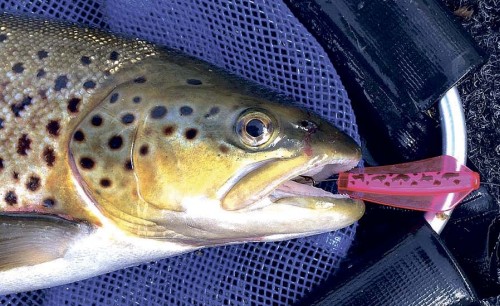 |
| A bright lure for later in the day. |
What is the thermocline you might ask? It is a layer of water so to speak where there sits a significantly cooler section of water most likely with an immediate change in oxygen levels also. Why it is attractive to fish I’m not sure of the scientific reasons but from an angling point of view the theory is sound so I’m not going to challenge it.
Run lures at the thermocline level and you’re well on your way. In NZ this is the basis of their trolling success and it works equally as well at home here in our own lakes.
The next item on the agenda is to look where we are fishing. Both waters again a reasonably large expanse and for the best part offer very good and specific inflows. The general water outside these inflows are great places to target late season. Please check the rules and regs of your chosen waters as they areas and vicinities to fish can vary. Again as a generally rule of thumb the trout should be congregating toward these inflows as the urge to spawn grows.
Run a spread of lures covering a few different colour variations but importantly try to cover the water column. One very good tip is to not just point your boat in a straight line. I very rarely do a curved corner also. Just turn in tight sharp angles, even if heading in a general direction, zig zag your way there. On the inside of the turn your lure will drop and slow and the outside lure will speed up. This not only alters your speed and depth but probably more importantly alters the action of the lure. It is quite uncanny just how often that inside rod will go off on a turn.
Drift spinning
I now find personally that covering the water more thoroughly through drift spinning a more successful tactic. While it is a lot more physically demanding and can be very tough on those wet and cold late autumn days the rewards can be good.
Again choosing your water is very important. That inflowing water is worth prospecting and probably more successful are the points either side of bays containing an inflowing creek. It is invariably windy at this time of year up top and the wind does create movement in the water. Current will form and these points help generate current lines and gather food. They also provide structure and a change in depth from the surrounds. All these lead to fish. Hit these spots and you will find reward. I personally prefer to target inflows with deeper water surrounding also. Sure you find them in the shallows but the deeper spots tend to be more successful I’ve found. Casting tight to the shore is a great starting point.
While it’s usually the best tactic, work around trying a few different ideas with depth and retrieves. You should discover a pattern. It may evolve over a day’s fishing also. Several times in recent years we’ve gone from a shallow shore based bite and moved out to 2-2.5m by midday to keep finding the bite.
Also take note of the bottom you are fishing over. Are you covering rocks? Or is it silt or weed? Possibly a broken bottom with a mixture of substrates. Whatever it is, it’s worth noting as if it works in one area it is most likely going to apply elsewhere in the same system. Look for structure. It may be trees in dead stands long drowned or freshly covered ground. Reefs, rocky outcrops and any inflowing water no matter how small. A little trickle running off a bank can a beacon for the more than one fish. And at this time of the year, where you catch one you are likely to find more.
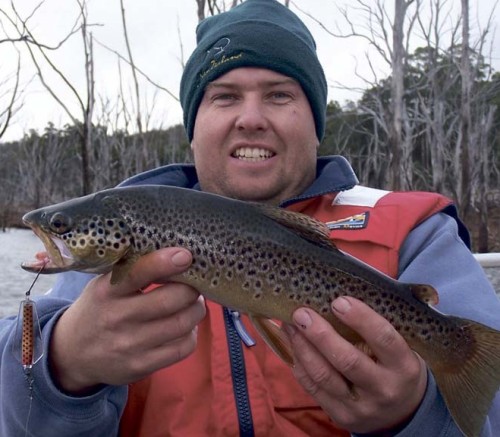 |
| Work around the trees. |
After dark
Another successful tactic that can be employed is the use of surface lures after night falls. It is in these hours where you can find the big fish. And we are often talking those trophy sized trout we all desire. Running water is once again the key. Trout of all sizes have the desire to spawn once they reach maturity. Some of these large trout will prey on that very fact. A fish in excess of 10lb in the old scale can make pretty light work of even a 300gr fish. They seemingly also can’t resist a surface lure popping across the top of the water. Mistaking it for a frog or mouse or whatever it may be but see it as an easy meal they do. Warmer nights seem to be a key here perhaps the extra insect life and surface action promoting a need for the fish to keep looking up for that feeding opportunity. Again check the local regulations for where and when you cannot fish.
Summary
You can apply this information to just about any still water in the state. Arthurs Lake having some very similar bays and creeks where similar tactics are used. Along with the likes, King William, Burbury, Pedder etc. It’s a rewarding time of the year to fish. Those days you remember forever can happen right now. Not only that when we get a settled day in autumn it’s generally a cracker and very enjoyable to be out on the water.
Apply some of this info to your next outing and it might help you find a few more fish. Stick at and where you find one there will be plenty more.
Remember to check out your rules and regs on the IFS Infish App or grab an info pamphlet from your local tackle store or Service Tas. They are invaluable tools and not only offer you the guidelines but the maps show inflows, bays and points, all that could point you to your next fish.
Justin Causby




